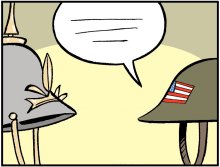 War Propaganda > World War I The Commitee on Public Information Previous | Next | Index  |
|
The absence of public unity was a primary concern when America entered the war on April 6, 1917. In Washington, unwavering public support was considered to be crucial to the entire wartime effort. On April 13, 1917, Wilson created the Committee on Public Information (CPI) to promote the war domestically while publicizing American war aims abroad. Under the leadership of a muckraking journalist named George Creel, the CPI recruited heavily from business, media, academia, and the art world. The CPI blended advertising techniques with a sophisticated understanding of human psychology, and its efforts represent the first time that a modern government disseminated propaganda on such a large scale. It is fascinating that this phenomenon, often linked with totalitarian regimes, emerged in a democratic state. Although George Creel was an outspoken critic of censorship at the hands of public servants, the CPI took immediate steps to limit damaging information. Invoking the threat of German propaganda, the CPI implemented "voluntary guidelines" for the news media and helped to pass the Espionage Act of 1917 and the Sedition Act of 1918. The CPI did not have explicit enforcement power, but it nevertheless "enjoyed censorship power which was tantamount to direct legal force." Like modern reporters who participate in Pentagon press pools, journalists grudgingly complied with the official guidelines in order to stay connected to the information loop. Radical newspapers, such as the socialist Appeal to Reason, were almost completely extinguished by wartime limitations on dissent. The CPI was not a censor in the strictest sense, but "it came as close to performing that function as any government agency in the US has ever done." Censorship was only one element of the CPI's efforts. With all the sophistication of a modern advertising agency, the CPI examined the different ways that information flowed to the population and flooded these channels with pro-war material. The CPI's domestic division was composed of 19 sub-divisions, and each focused on a particular type of propaganda. A comprehensive survey is beyond the scope of this paper, but the use of newspapers, academics, artists, and filmmakers will be discussed. One of the most important elements of the CPI was the Division of News, which distributed more than 6,000 press releases and acted as the primary conduit for war-related information. According to Creel, on any given week, more than 20,000 newspaper columns were filled with material gleaned from CPI handouts. Realizing that many Americans glided right past the front page and headed straight for the features section, the CPI also created the Division of Syndicated Features and recruited the help of leading novelists, short story writers, and essayists. These popular American writers presented the official line in an easily digestible form, and their work was said to have reached twelve million people every month. The Division of Civic and Educational Cooperation relied heavily on scholars who churned out pamphlets with titles such as The German Whisper, German War Practices, and Conquest and Kultur. The academic rigor of many of these pieces was questionable, but more respectable thinkers, such as John Dewey and Walter Lippmann, also voiced their support for the war. Even in the face of this trend, however, a few scholars refused to fall in line. Randolph Bourne had been one John Dewey's star students, and he felt betrayed by his mentor's collaboration with the war effort. In one of several eloquent wartime essays, Bourne savagely attacked his colleagues for self-consciously guiding the country into the conflict. "[T]he German intellectuals went to war to save their culture from barbarization," wrote Bourne. "And the French went to war to save their beautiful France!... Are not our intellectuals equally fatuous when they tell us that our war of all wars is stainless and thrillingly achieving for good?" The CPI did not limit its promotional efforts to the written word. The Division of Pictorial Publicity "had at its disposal many of the most talented advertising illustrators and cartoonists of the time," and these artists worked closely with publicity experts in the Advertising Division. Newspapers and magazines eagerly donated advertising space, and it was almost impossible to pick up a periodical without encountering CPI material. Powerful posters, painted in patriotic colors, were plastered on billboards across the country. Even from the cynical vantage point of the mid 1990s, there is something compelling about these images that leaps across the decades and stirs a deep yearning to buy liberty bonds or enlist in the navy. Moving images were even more popular than still ones, and the Division of Films ensured that the war was promoted in the cinema. The film industry suffered from a sleazy reputation, and producers sought respectability by lending wholehearted support to the war effort. Hollywood's mood was summed up in a 1917 editorial in The Motion Picture News which proclaimed that "every individual at work in this industry wants to do his share" and promised that "through slides, film leaders and trailers, posters, and newspaper publicity they will spread that propaganda so necessary to the immediate mobilization of the country's great resources." Movies with titles like The Kaiser: The Beast of Berlin, Wolves of Kultur, and Pershing's Crusaders flooded American theaters. One picture, To Hell With The Kaiser, was so popular that Massachusetts riot police were summoned to deal with an angry mob that had been denied admission. The preceding discussion merely hints at the breadth of CPI domestic propaganda activities. From lecture hall podiums and movie screens to the pages of popular fiction and the inside of payroll envelopes, the cause of the Allies was creatively publicized in almost every available communication channel. But this is only part of the story. The propaganda techniques employed by the CPI are also fascinating, and, from the standpoint of democratic government, much more significant. |
| Comments to author: [email protected] |